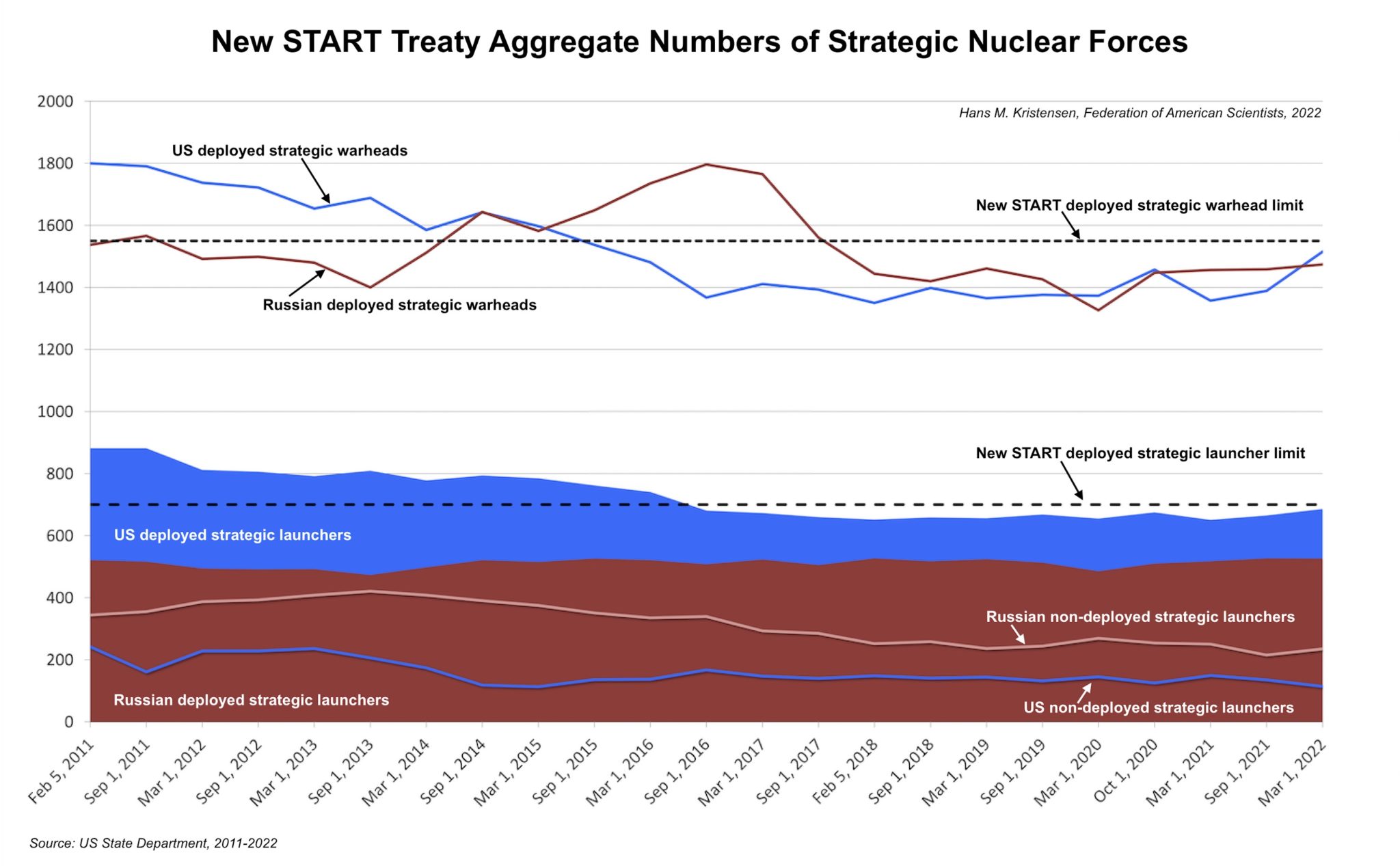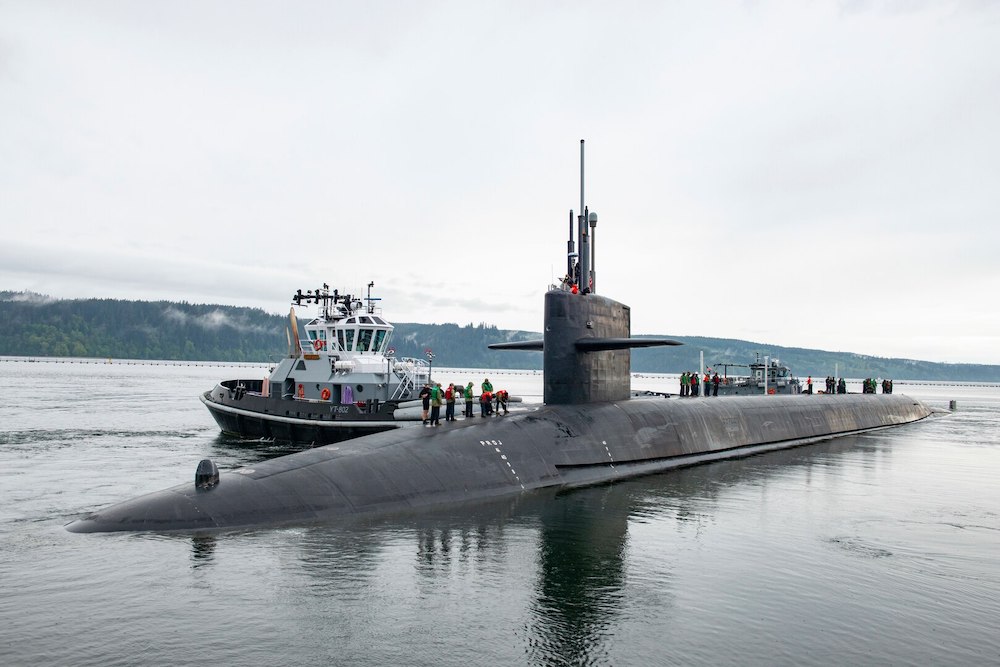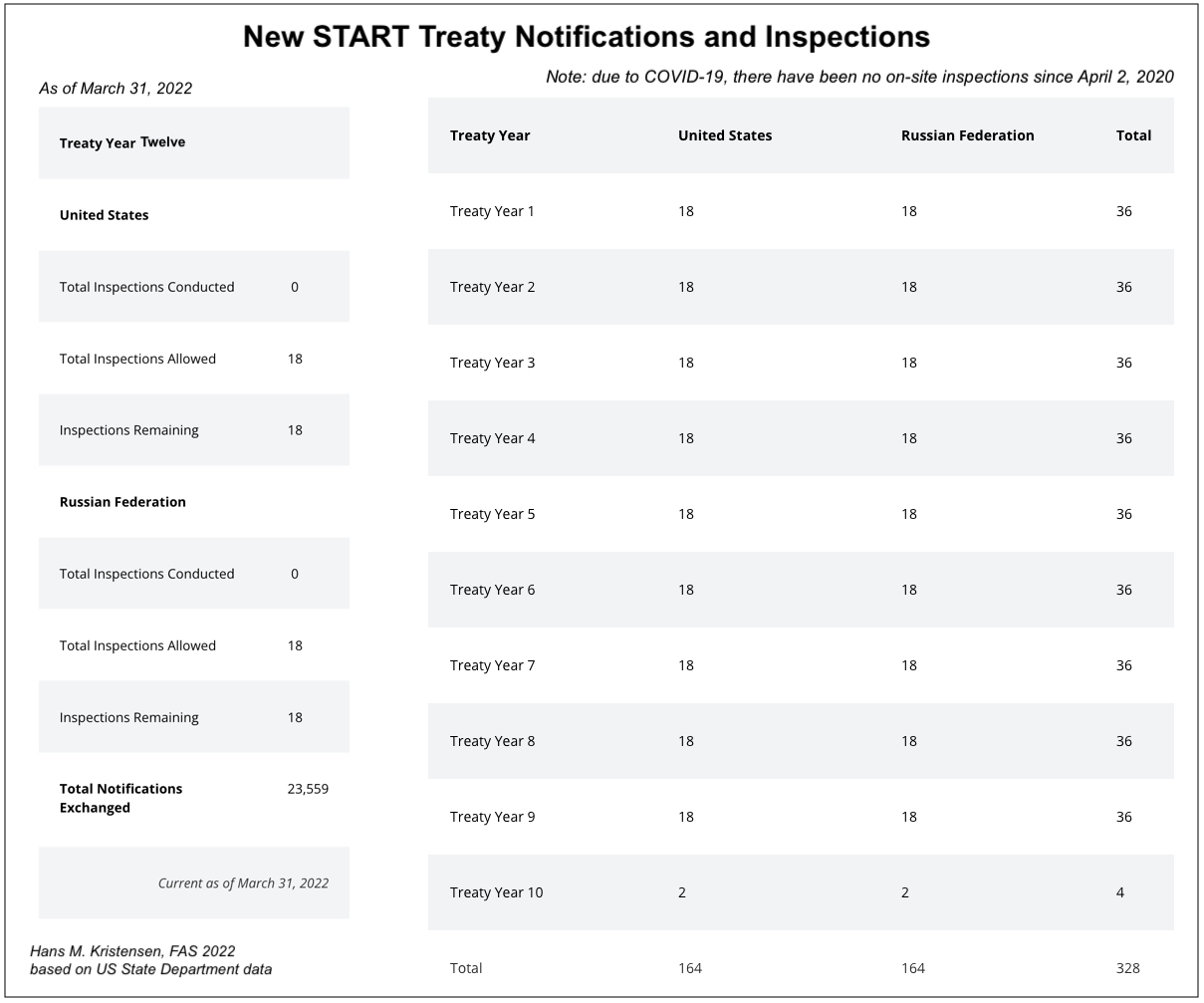Amidst Nuclear Saber Rattling, New START Treaty Demonstrates Importance
Shortly after Russian military forces invaded Ukraine and President Vladimir Putin said that he had ordered Russian nuclear forces on high combat alert – apparently to deter the United States from getting directly involved, and the United States condemned the statement as “unacceptable” nuclear saber rattling but refused to respond in kind, the two vehemently opposed countries did something amazing: They exchanged factual information about the status of their strategic nuclear forces as required under the New START Treaty.
Yesterday, the US State Department published the unclassified bits of that data exchange. It shows that both countries were below the limits set by the treaty for deployed strategic nuclear forces: 1,550 warheads attributed to 700 deployed long-range ballistic missiles and heavy bombers.
At a time when direct contacts are being curtailed, antagonism runs high, and trust completely lost, it is nothing short of amazing that Russia and the United States continue to abide by the New START treaty and exchange classified information as if nothing had happened.
The reason is clear. Despite their differences, they both have a keen interest in keeping the other country’s long-range nuclear forces in check.
Both the United States and Russia have far more nuclear warheads in their total military stockpiles than what they deploy on their launchers under New START. If the treaty fell away, each side could dramatically and quickly increase the number of nuclear warheads ready to launch on short notice. The US has close to 2,000 strategic warheads in storage, Russia about half that many. Such an increase would be extraordinarily destabilizing and dangerous, especially with a full-scale war raging in Europe and Russia buckling under the strain of unprecedented sanctions.
What the Data Shows

The latest set of data shows that as of March 1, 2022, the United States and Russia both were in compliance with their obligations under the New START treaty not to operate more than 800 total strategic launchers, no more than 700 deployed strategic launchers, and no more than 1,550 warheads attributed to those deployed launchers.
Combined the two countries possessed a total of 1,561 accountable strategic missiles and heavy bombers, of which 1,212 launchers were deployed with 2,989 attributable warheads. That is a slight increase in the number of deployed launchers and warheads compared with six months ago (note: the combined warhead number is actually about 100 too high because each deployed bomber is counted as one weapon even though neither country’s bombers carry weapons under normal circumstances).
Compared with September 2021, the data shows the two countries combined increased the total number of strategic launchers by 19, increased combined deployed strategic launchers by 20, and increased the combined deployed strategic warheads by 142. Of these numbers, only the “19” is real; the other changes reflect natural fluctuations as launchers move in and out of maintenance or are being upgraded.
In terms of the total effect of the treaty, the data shows the two countries since February 2011 combined have cut 428 strategic launchers from their arsenals, reduced deployed strategic launchers by 191, and reduced the number of deployed strategic warheads by 348. However, it is important to remind that this warhead reduction is but a fraction (just over 4 percent) of the estimated 8,185 warheads that remain in the two countries combined nuclear weapons stockpiles (just over 3 percent if counting their total combined inventories of 11,405 stockpiled and retired (but yet to be dismantled) warheads).
The United States
The data shows the United States possessing 800 strategic launchers, exactly the maximum number allowed by the treaty, of which 686 are deployed with 1,515 warheads attributed to them. This is an increase of 21 deployed strategic launchers and 126 deployed strategic warheads over the past 6 months. The increase is probably partly due to the 13th SSBN – the USS Wyoming (SSBN-742) – having completed its reactor refueling overhaul. The 1,515 deployed warheads is the highest number the United States has deployed since September 2015. The total inventory of strategic launchers has not declined since 2017.
The aggregate data does not reveal how many warheads are attributed to the three legs of the triad. The full unclassified data set will be released later this summer. But if one assumes the number of deployed bombers and deployed ICBMs are the same as in the September 2021 data, then the SSBNs carry 1,068 warheads on roughly 220 deployed Trident II SLBMs. That is an increase of 123 warheads on the SSBN force compared with September, or an average of 4-5 warheads per deployed missile. Overall, this accounts for roughly 70 percent of all the 1,515 warheads attributed to the deployed strategic launchers (nearly 73 percent if excluding the “fake” 45 bomber weapons included in the official count).

The New START data indicates that the United States as of March 1, 2022 deployed approximately 1,068 warheads on ballistic missile onboard its strategic submarines.
Compared with February 2011, the United States has reduced its total inventory of strategic launchers by 324, deployed launchers by 196, and deployed strategic warheads by 285. While important, the warhead reduction represents only a small fraction (about 8 percent) of the estimated 3,708 warheads that remain in the U.S. stockpile (just over 5 percent if counting total inventory of 5,428 stockpiled and retired (but yet to be dismantled) warheads).
The Russian Federation
The New START data shows Russia with an inventory of 761 strategic launchers, of which 526 are deployed with 1,474 warheads attributed to them. Compared with six months ago, this is a decrease of 1 deployed launcher and an increase of 16 deployed strategic warheads. The change reflects fluctuations caused by launcher maintenance and upgrade work to new systems.
Compared with February 2011, Russia has cut its total inventory of strategic launchers by 104, increased deployed launchers by 5, and decreased deployed strategic warheads by 63. This modest warhead reduction represents less than 2 percent of the estimated 4,477 warheads that remain in Russia’s nuclear weapons stockpile (roughly 1 percent if counting the total inventory of 5,977 stockpiled and retired (but yet to be dismantled) warheads).
The Russian New START reductions since 2011 are smaller than the US reductions because Russia had fewer strategic forces than the United States when the treaty entered into force.
That disparity remains today. Despite frequent claims by hardliners that Russia is ahead of the United States, the New START data shows that Russia has 160 deployed strategic launchers fewer than the United States, a significant gap that exceeds the number of missiles in an entire US Air Force ICBM wing. Despite its nuclear modernization program, Russia has so far not sought to reduce this gap by deploying more strategic launchers. Instead, the Russian launcher deficit has been increasing by about one-third since its lowest point in February 2018.
Instead of closing the launcher gap, the Russian military appears to try to compensate by increasing the number of warheads that can be carried on the newer missiles (SS-27 Mod 2, Yars, and SS-N-32, Bulava) that are replacing older types (SS-25, Topol, SS-N-18, Vysota, and SS-N-23, Sineva). Thanks to the New START treaty limit, many of these warheads are not deployed on the missiles under normal circumstance but are stored and could potentially be uploaded onto the launchers in a crisis. The United States also has such an upload capability for its larger inventory of launchers and therefore is not at a strategic disadvantage.
Two of Russia’s new strategic nuclear weapons (SS-19 Mod 4, Avangard, and SS-29, Sarmat) are covered by New START if formally incorporated. Other types (the Poseidon nuclear-powered torpedo, and the Burevestnik nuclear-powered ground-launched cruise missile) are not yet deployed and appear to be planned in relatively small numbers. They do not appear capable of upsetting the strategic balance in the foreseeable future. The treaty includes provisions for including new weapon types, if the two sides agree.
The sanctions in reaction to Russia’s invasion of Ukraine will likely slow Russia’s nuclear modernization in the next decade.
Inspections and Notifications
In addition to the aggregate data described above, the New START treaty also allows for up to 18 on-site inspections per year and notifications of launcher movements and activities. Up until April 2020, a total of 328 on-site inspections were conducted. Because of COVID-19, there have been no inspections since. The two countries have continued to exchange large numbers of notifications: a total of 23,559 as of March 31, 2022.

Looking Ahead
The continued complaince by the United States and Russia to the New START treaty and its data exchanges are extraordinary given the demise of treaties, agreements, and deep animosity and almost complete loss of trust. The treaty’s interactions between the two countries and the caps and predictability it provides on strategic offensive nuclear forces have never been more important since New START was negotiated more than a decade ago.
But the clock is running out. Although New START was extended in February 2021 for an additional five years, the treaty will expire in February 2026. Strategic stability talks between Russia and the United States have been disrupted by the war in Ukraine and seem unlikely to resume in the foreseeable future.
If New START is not followed by a new treaty by the time it expires in 2026, there will no limits on US and Russian nuclear forces for the first time the 1970s.
Moreover, political polarization makes it highly uncertain if the US Congress would approve a new treaty.
Short of a formal treaty, the two sides potentially could make an executive agreement and pledge to continue to abide by the New START limits even after the treaty officially expires.
The silver lining is that both countries have a strong interest in continuing to maintain limits on the other side’s strategic offensive nuclear forces. That is why it is important that hardliners are not allowed to misuse Russia’s invasion of Ukraine and China’s nuclear buildup to undermine New START and increase nuclear forces.
Additional information:
- Status of World Nuclear Forces
- Russian nuclear forces, 2022
- United States nuclear forces, 2021 [2022 version forthcoming]
This publication was made possible by generous support from the John D. and Catherine T. MacArthur Foundation, the New Land Foundation, the Ploughshares Fund, and the Prospect Hill Foundation. The statements made and views expressed are solely the responsibility of the author.
The FY2026 National Defense Authorization Act (NDAA) paints a picture of a Congress that is working to both protect and accelerate nuclear modernization programs while simultaneously lacking trust in the Pentagon and the Department of Energy to execute them.
While advanced Chinese language proficiency and cultural familiarity remain irreplaceable skills, they are neither necessary nor sufficient for successful open-source analysis on China’s nuclear forces.
Satellite imagery has long served as a tool for observing on-the-ground activity worldwide, and offers especially valuable insights into the operation, development, and physical features related to nuclear technology.
This report outlines a framework relying on “Cooperative Technical Means” for effective arms control verification based on remote sensing, avoiding on-site inspections but maintaining a level of transparency that allows for immediate detection of changes in nuclear posture or a significant build-up above agreed limits.